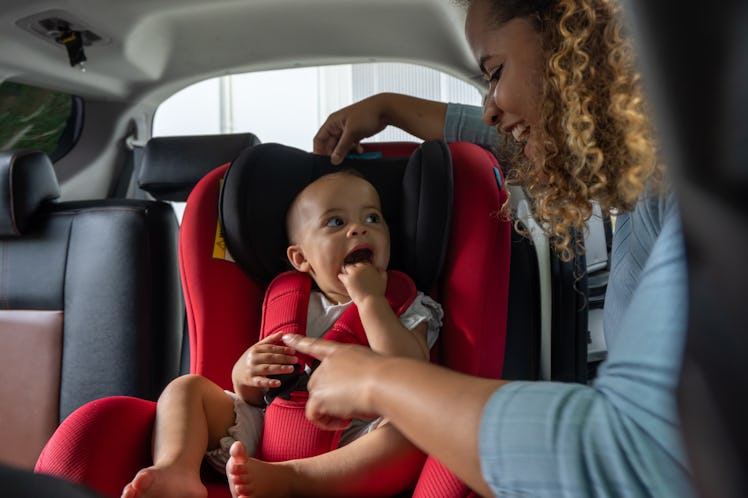What Every Parent Needs To Know About Car Seat Head Support For Infants
Does your infant look like a bobblehead in the car seat? They shouldn't. Here's what to do.

When strapped into an infant car seat, infants and young children’s heads tend to wobble and bobble because they lack the neck muscles to support their heads. But before you stock up on car seat head supports, pillows, wraps, or infant car seat alarms, know this: Manufacturers are well aware of your baby’s lack of neck muscles. They’ve taken into account an infant’s still-developing spine and the potential damage of head flops. The car seats are tested with this in mind. If you’re installing them correctly, your child should be safe. But chances are you’re probably not installing them the right way.
First, consider a child’s physiology. During the early stages of an infant’s vertebrate development, ligaments and tendons are extra stretchable. This explains why infants don’t really experience sprains, but also why a baby’s head flopping to the side, while terrifying to see, is relatively low-risk. It’s when a baby’s head flops forward that major issues can result, as airways can become restricted. If a baby’s poorly positioned in a baby car seat or slumped over in a forward-facing wrap or carrier, parents should absolutely be concerned.
“The way the manufacturer intends car seats to be installed, there shouldn’t be a lot of head flopping forward. If you see a child’s head falling forward in an installed seat, it’s probably installed at the wrong angle,” says Ben Hoffman, M.D., Oregon Health and Sciences University pediatrician. In that case, you need to fix the angle of the car seat to provide more head support.
Car Seat Installation for Best Head Support
Easier said than done. According to Hoffman, 80% of rear-facing car seats are installed incorrectly, and a whopping 95 percent of families with newborns make critical mistakes with car seats. Parents are strongly urged to get their seats checked by a certified technician. And, no, despite rumors to the contrary, firefighters cannot and should not stand in for technicians.
“Some of the most creative and frankly wrong car seat installations I’ve seen have been by well-meaning, uncertified firefighters,” says Hoffman.
Parents still concerned about the head support offered by their child’s car seat might be tempted to resort to animal-shaped neck braces, baby head wraps, inserts, or other apparatus intended to keep the head stationary. Hoffman recommends that they don’t.
“I wouldn’t put anything around my baby’s neck, to be honest. There’s not going to be any peer-reviewed data on those things, and that’s the gold standard,” he says. “I think what happens is those things can make a parent complacent. That’s where things are going to happen, especially if there’s something around a baby’s neck.”
Bottom line: A properly installed car seat should prevent flop-forward injuries, but not necessarily some side-to-side bobbling. And that’s okay. Some bobbling is to be expected. Headbanging, however, is not.
This article was originally published on